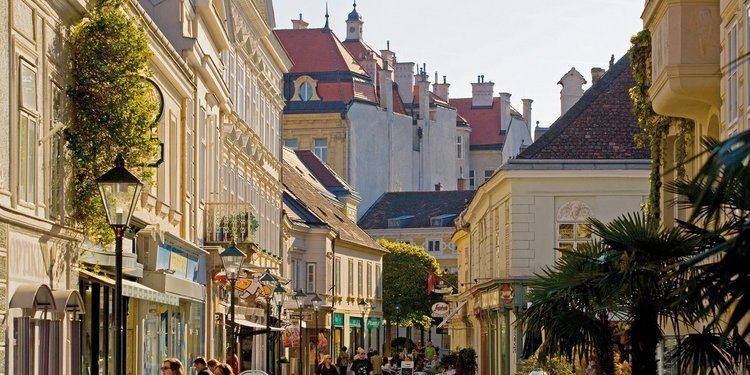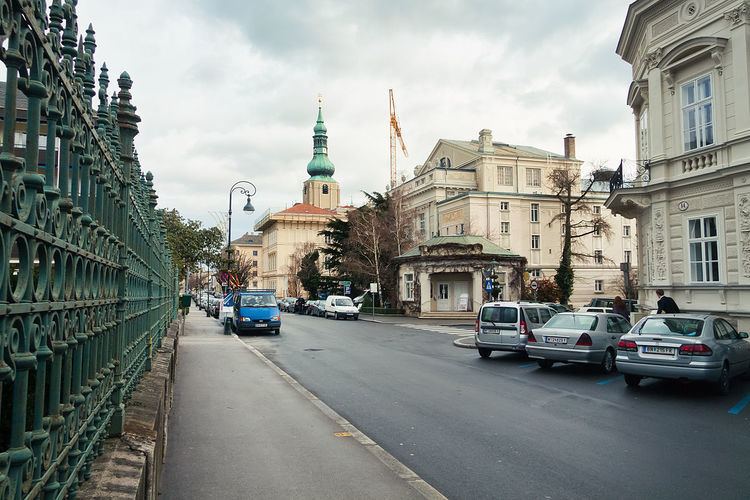Country State Mayor Kurt Staska (OVP) | Area 26.89 km2 District Baden Population 25,156 (Apr 1, 2009) | |
 | ||
Map of Baden bei Wien
Baden (German for "Baths"), unofficially distinguished from other Badens as Baden bei Wien (Baden near Vienna), is a spa town in Austria. It serves as the capital of Baden District in the state of Lower Austria. Located about 26 km (16 mi) south of Vienna, the municipality consists of cadastral Baden, Braiten, Gamingerhof, Leesdorf, Mitterberg, Rauhenstein, and Weikersdorf.
Contents
- Map of Baden bei Wien
- Baden bei wien
- Baden bei wien baden near vienna
- Geography
- History
- Transportation
- Government
- Natives
- Residents
- References

Baden bei wien
Baden bei wien baden near vienna
Geography

Baden is located at the mouth of the Schwechat River's St Helena Valley (Helenenthal) in the Vienna Woods (Wienerwald) range. It takes its name from the area's 13 hot springs, which vary in temperature from 72 to 97 °F (22 to 36 °C) and contain lime sulphate. They lie for the most part at the foot of Mt Calvary (Calvarienberg; 1,070 ft or 326 m).
The highest point in the area is the Iron Gate (Eisernes Tor or Hoher Lindkogel), whose 2,825 ft (861 m) can be ascended in about three hours.
History
The celebrity of Baden dates back to the days of the Romans, who knew it by the name of Aquae Cetiae or Thermae Pannonicae. Some ruins are still visible. The settlement was mentioned as Padun in a deed from AD 869. The nearby abbey of Heiligenkreuz's Romanesque church was constructed in the 11th century; it subsequently served as the burial place for members of the Babenberg family. The castle Rauheneck was constructed on the right bank of the river at the entrance to the valley in the 12th century; the castle Rauhenstein was built on the opposite bank at the same time. The town received its legal privileges in 1480. Although repeatedly sacked by Hungarians and Turks, it soon flourished again each time.
The town was largely destroyed by a fire in 1812 but was excellently rebuilt in a Biedermeier style according to plans by architect Joseph Kornhäusel, it is therefore sometimes referred to as the "Biedermeierstadt". Archduke Charles, the victor of Aspern, constructed the Château Weilburg at the foot of Rauheneck between 1820 and 1825. In the 19th century, it was connected to the railway running between Vienna and Graz, which led to thousands of Viennese visiting each year to take the waters, including members of the imperial family, who constructed extensive villas nearby. The town boasted a theater, military hospital, and casino. The composer Ludwig van Beethoven stayed a number of times in Baden and his residences still form local tourist spots. The location at Rathausgasse 10 now forms a museum open to the public. Mayerling, a hunting lodge about 4 mi (6.4 km) up the valley, was the site of Crown Prince Rudolf's murder-suicide in 1889. Its primary export in the 19th century were steel razors, which were reckoned of excellent quality.
The City Theater (Stadttheater) was built in 1909 by Ferdinand Fellner. By the time of the First World War, Baden was Vienna's principal resort: 20 000 came each year, double the town's local population. In addition to a modern "Curehouse" (Kurhaus), there were 15 separate bathing establishments and several parks. During the war, Baden served as a temporary seat of the Austro-Hungarian high command. A new casino in 1934 made the town the premier resort throughout Austria. The Château Weilburg was destroyed during World War II. After World War II, Baden served as the headquarters of Soviet forces within occupied Austria until 1955.
Transportation
Baden can be reached by the Süd Autobahn (A2) and is linked with the Südbahn railway line (including S-Bahn line S9) at the Baden train station as well as with the Badner Bahn tram-train to Vienna.
Government
Kurt Staska (ÖVP) is Baden's Bürgermeister as a result of elections of 2010, but he resigned at the end of 2016 and Szirucsek became the new Bürgermeister (Mayor). His deputy is Helga Krismer from the Greens.
Local board (German: Gemeinderat) consists of 41 places:
